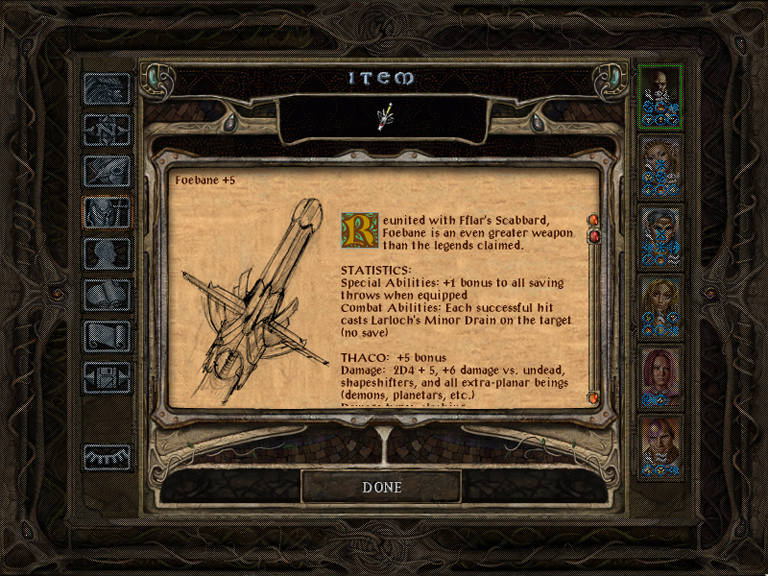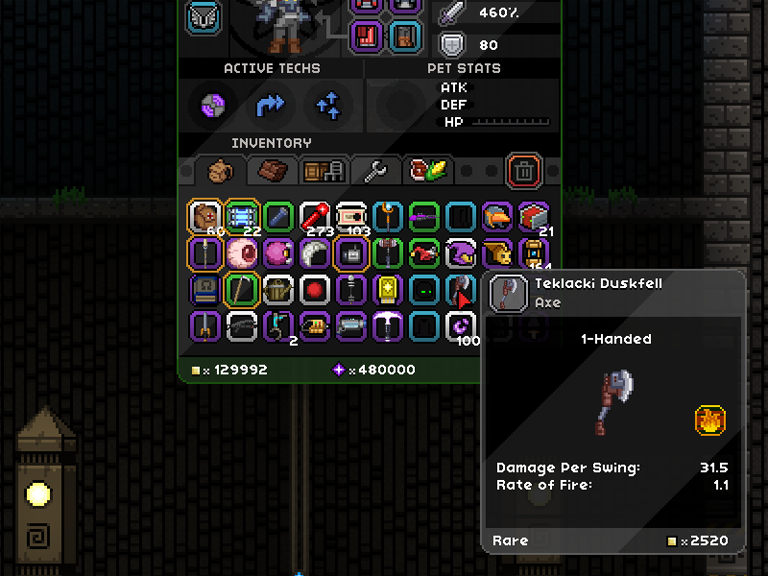It was a tough fight.
Not the hardest you've endured, but – tricky. Very tricky. Your opponent was surprisingly lateral: always doing the unexpected, never moving the way you thought they would. It gave you a few genuine scares – startling instants when you could feel the chill of fear creeping down your spine, with the outcome less certain than a tossed coin in midair... But, in the end, you proved better. You persevered. And now it was over. Finally over... You stood victorious.
Just past the site of your confrontation, there was an alcove; within the alcove, a chest. Nothing special, really. Nothing ornate or lavish, but – you knew. Somehow you just knew: the prize – well-deserved reward for all your toil and strain – was contained within... Your hands, which remained steady throughout the fight, trembled — shook imperceptibly with anticipation. You undid the hasp. Prised open the lid... Lifted it. Held it open and reached within...
Seriously? An Amulet of Deflection +2!? But I'm wearing a +3...
I'm no game historian. I don't know when it happened – only that it did – and there now exist two distinct approaches to the way items are handled in games: the (preferred) scarcity of before and the (silly) overabundance of after. And neither works.

Before took place in your Baldur's Gates, your Fallouts or KOTORs: for the majority of playtime, you kept finding humdrum, run-of-the-mill weapons and armor and then – every now and again (usually following a particularly tough fight) – you'd stumble upon an item that was extraordinary; one that conferred a strength bonus, protected against level drain or set your opponents ablaze... Then you would wade through another broad expanse of mundanity before stumbling onto some other gem.
It was a system that made some semblance of sense (tougher opponents = better stuff) and one that delineated a definite distinction between the acreage of meh and the rare hillocks of wowza.
The only problem was that items were static: however you found them is how they persisted, which meant that – with the inexorable advancement of your character and the corresponding increase in difficulty from more powerful opponents – obsolescence was sorta built into the system. Eventually, within an hour or two of gameplay, a cherished item would no longer be useful and you would need a more powerful version thereof to keep going.

After started with Diablo (I think) and its intriguing (though ultimately flawed) "random prefix and suffix" means of generating items, which eventually gave rise to equipment tiers (most prominently displayed in Borderlands and most recently in Cyberpunk 2077) and crafting (look no further than Diablo II).
Here, the scarcity of before was replaced by a deluge of "minute variations": items that functioned more or less the same, differing only by an extra sliver of damage or an additional point or two of armor. This system made no sense at all.
Running as it was on "random" drop tables, there was largely no telling when, where or even why you would acquire something and what quality it would be. Never mind the inanity of finding a greataxe on a bat, the random nature of how items were "generated" (instead of found) padded out gameplay in the worst way possible — by necessitating grinding.
But regardless of how either system functioned, both failed to address the core failing of having character efficiency depend on equipment: that items – and not the ability or skill of their owner – were ultimately what defined how effective said owner would be...
If you look at real life, the disconnect within both systems seems obvious. When a veteran firefighter combats a blaze by using a water hose, their success isn't dictated by whether or not the hose is magical: it is dictated by years of experience and corresponding skill. The hose is merely a modifier that allows the firefighter to do something they could otherwise not do (i.e. shape and direct water), but whether the blaze is put out effectively is entirely down to the firefighter knowing where to direct the water stream...
The reasoning of both systems makes a semblance of sense: before, when character abilities were static and levels gave you more attacks and hit points, the only way to make a character more powerful was by equipping more powerful items; after, with its (often) more limited gameplay (basically shoot and loot, with a bare minimum of story), on the other hand, depended on grinding for items to (unnaturally) extend the length of the game.
What I don't understand, however, is why – to this day – so few devs have bothered to address these limitations (The Outer Worlds kinda did, though their approach still fell short in the end). Especially because the solution seems so easy and obvious.
For the ambitious (and loaded) dev, it would be as simple as making items resemble characters in structure: giving them components (which could be upgraded for better stats), abilities you could invest in or levels you could raise. The core gameplay would be unaffected – you would still need to gather ingredients or experience to be able to improve an item – but the obsolescence would be taken care of, so if you found an item you liked the look of but wished it were better, you would no longer need to discard it in favor of something new (unless you wanted to — in which case, more power to ya).
Making a new mechanic that changed item appearance (from simple re-texturing to entirely new components) would neatly round out the improvement, but even without it (if item appearance remained static, but its statistics changed) it'd be a way to circumvent the shortcomings of the current way of handling item construction.
In this example, if you found a (let's be basic) short sword +1, +2 against goblins (sorry gobos) and needed it to be stronger (to account for Goblins That Work Out), you could simply find a recipe for re-forging the blade, gather the ingredients, perform the upgrade and – presto! – here comes a short sword +2, +4 against goblins. Same look, same handling – better stats.
For the dev on a budget, you could leave items static but give the character more abilities pertaining to their use. So instead of the item getting stronger (which, traditionally, static objects don't do), the character would simply become more adept in handling them.
In this instance, the short sword from the previous example would remain +1, +2 against goblins, but the character would deal extra +1, +2 damage when using it. This way, the item could remain useful and game-play would not be short-changed (because, presumably, you would still need to gather enough XP to raise the necessary ability).
The ideal solution, of course, would be combining these two approaches for a mechanic that would 1) leave the competence of a character solely up to the character (and not their equipment); 2) get rid of item obsolescence (and the need for the endless stream of "upgrades"); and 3) let the changing of equipment be a player decision instead of a necessary inevitability (so if you wanted to try something new, you could, but if you liked the stuff you had, you could simply improve it).
Why, to this day, devs doggedly persist in treating items the same way as games of the past 10 or even 20 years (either by using crafting to prolong usefulness of an item before you have to discard it or by constantly providing better replacements) is beyond me – especially when the solution wouldn't necessarily be more work intensive than the ones currently in use... Then again – aside from not being a historian – I am also not clairvoyant.
What I do know is that implementing either of these solutions could improve gameplay and (probably) not unduly complicate the development process... And most importantly, it would finally de-trivialize finding new loot after a particularly harrowing boss fight and put some excitement back into hamstering in games...
